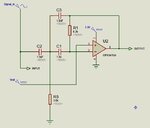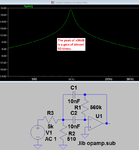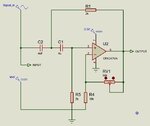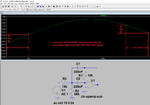adrian1232
Junior Member level 1
Hi all,
I need to implement a high-pass filter to eliminate baseline drift to my signal. The wanted frequency range is between 25Hz to 400Hz. I alteady implemented a low-pass filter to remove any unwanted noise above 400Hz.
I need the high-pass filter to have an adjustable gain from 1 to 40 by using a potentiometer.
Are there circuits/ICs to implement the high-pass filter with an order of at least 2?
I tried several designs, with the one attached (Multiple Feedback filter) providing the best results. The problem that I am having with this design is the gain. Why is the gain increasing with the input frequency? and what resistor has to be varied to adjust the gain?
Any help would be greatly appreciated.

I need to implement a high-pass filter to eliminate baseline drift to my signal. The wanted frequency range is between 25Hz to 400Hz. I alteady implemented a low-pass filter to remove any unwanted noise above 400Hz.
I need the high-pass filter to have an adjustable gain from 1 to 40 by using a potentiometer.
Are there circuits/ICs to implement the high-pass filter with an order of at least 2?
I tried several designs, with the one attached (Multiple Feedback filter) providing the best results. The problem that I am having with this design is the gain. Why is the gain increasing with the input frequency? and what resistor has to be varied to adjust the gain?
Any help would be greatly appreciated.




